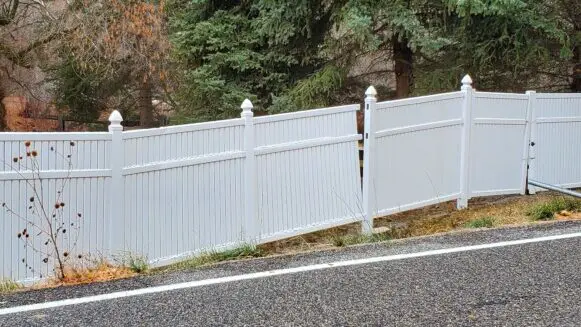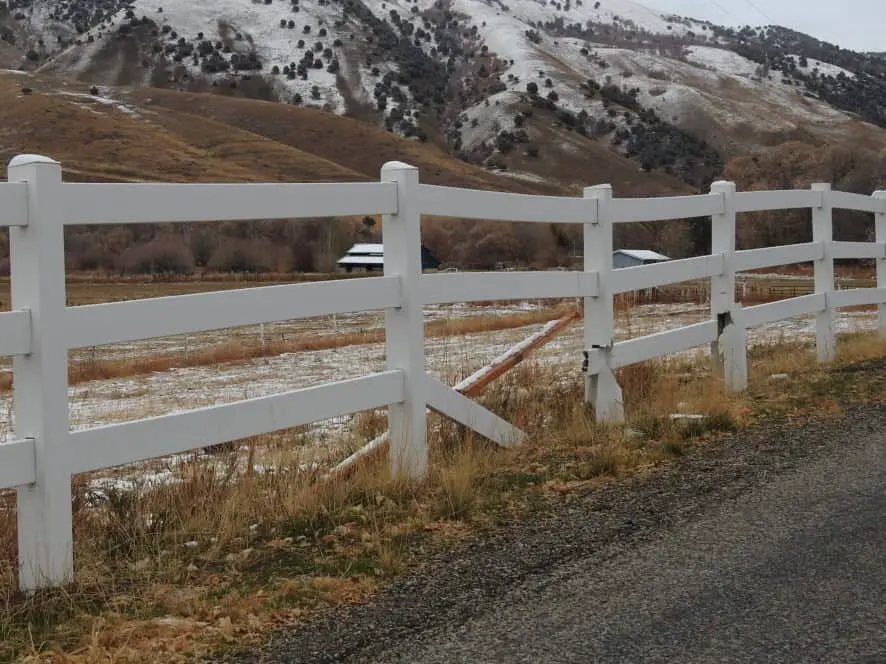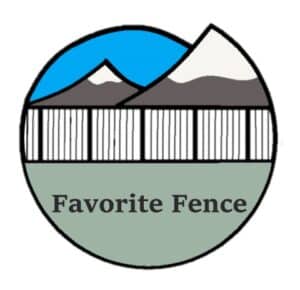As homeowners consider vinyl fencing as a solution for their perimeter fencing needs, one common question many ask is whether a vinyl fence will warp.
Vinyl fencing is not subject to moisture saturation or outdoor degradation that may cause other materials to lose their structural integrity and warp. However, if installed incorrectly or mal treated, vinyl fencing may be forced to bow or become disjointed and forced out of alignment.

Vinyl Fencing is NOT Prone to Warping
Wood and composite materials are subject to warping when their surface absorbs water and/or dries unevenly. As the material becomes saturated, the wood and composite fibers swell. When the material dries, it contracts. If water absorption and drying occur unevenly, some of the fibrous grains may be subject to swelling and contraction while other portions may hold their original shape. In the end the material may twist, warp, or bow out of its original form. My favorite term for this is “skiwampus”—an unsuitable material state for building and construction.
Vinyl fencing is made out of polyvinyl chloride—PVC. It does not absorb water and does not warp. Vinyl fencing is fortified with strengthening modifiers to not only add strength and flex, but also to repel UV radiation and damage from the elements.
Vinyl fencing is an exceptionally strong and durable material that will retain its original shape and resist outdoor degradation for decades. It is typically manufactured via dual extrusion—a process that melds an inner layer to an outer layer and shaped through a mold. It does not warp, bow, or fade when installed correctly.
Proper installation of vinyl fencing involves installing each post in a post hole that has been dug roughly three times the width of the post and approximately 36 inches deep—or half of the post’s designed above surface height. High-strength concrete is added to each post hole within 3-4 inches of the surface.
The solid base enables the post to withstand soil settling, heaving, and swelling. Subsequently, the post retains its original position and maintains the alignment of the fenceline.
Mistreatment May Damage the Integrity of Vinyl Fencing
Applications applied to a vinyl fence that are not approved or recommended by the manufacturer may cause damage and degrade, instead of enhance, the PVC material.
For example: painting a vinyl fence with a water or oil-based paint is discouraged by all vinyl fence manufacturers. Paint, in general, does not bond well with materials made out of polyvinyl chloride (PVC). Additionally, the paint may absorb UV radiation where the PVC fencing is fortified and designed to deflect it.
As the UV radiation is unduly exposed to the PVC, it causes free radicals to form that develop into micro hairline fractures within the material that lead to the warping, sagging or bowing of the product. The mistreatment of vinyl fencing material causes a premature disposition to, and the acceleration of, UV and outdoor degradation.
Other forms of mistreatment that may cause damage to vinyl fencing are:
- Potent Cleaning Chemicals: cleaners with high concentrations of TSP or bleach.
- Cleaning Abrasives: scrubbing brushes or scouring pads that damage the outer layer of the fencing material.
- Polyurethane Treatments: normally used on wood fencing—are not recommended or needed for vinyl fencing materials.
- High Pressure Power Washing: the high-pressure water can gore into and damage the cap-stock, or outer layer of the vinyl fencing material. If using a power washer, do not use a nozzle less than 40°, and do not exceed 2500 PSI. And, do not hold the wand closer than 18 inches.
Similar to the damage that paint may cause to the vinyl surface, these additional treatments may remove or damage the UV inhibitors melded into the outer layer, or cap-stock, of the vinyl fence material. The fence may become subject to UV damage and outdoor degradation and rapidly lose its structural integrity and become subject to warping and bowing.
Proper cleaning of a vinyl fence involves using water, or a mild eco friendly detergent and if necessary, a soft scrubbing agent.
Improper Installation Is a Major Cause of Vinyl Fence Issues
A vinyl fence that is not installed per manufacturer recommendations, for example: without the recommended amount of concrete in the post hole, may not be able to maintain proper alignment or solid placement. Mal-prepped post holes may be subject to soil swelling, settling, or heaving which may cause undue pressure along the fenceline.

Another installation oversight that may cause problems with the posts being forced out of alignment arises with the improper post prep when installing a fence on sloped terrain. Even though the terrain may have an upward or downward gradient the post is still installed directly vertical.
Proper preparation of posts installed along sloped terrain involves enlarging the slots that are routed out of the post to receive the top and bottom rails. When the rails are received into the post at an angle, the slots must be enlarged to properly receive them.
If the rails are forced into the post without enlarging the slots, a fulcrum of constant pressure is created that will eventually cause the post shift or become unseated.
The improper installation of the post in the posthole or preparation of the post can lead to the following issues:
- Misalignment: the posts are pushed or pulled out of alignment.
- Bowing and Sagging: the posts are pushed closer together forcing the material to warp, bow or sag.
- Disconnection: the posts are pushed further apart causing top and bottom rails to slide out or break away from the post.
Additional Causes of Vinyl Fence Warping and Bowing
Additional conditions that may cause bowing or misalignment may not be associated with the post but rather to other areas along the fence line.
- Insufficient bottom rail excavation: if the bottom rail is set with direct contact to the ground, soil swelling and frost heaving may force the bottom rail upward or outward and may cause bowing.
- Prevention may require adjusting the fence line prior to installation. Or excavation below the bottom rail of a preinstalled fence to allow 2-3 inches of space.
- Vegetation encroachment: if left unattended, vegetation such as trees, shrubbery and long grasses may grow up against the fence and apply pressure against the rails and pickets causing bowing and the appearance of warping. They can also build bulky root systems that may force the post or bottom rails out of their original position.
Vinyl Fencing and Roadside Conditions
If you’ve ever driven down a highway road and noticed a property perimeter cased with a vinyl fence in extreme poor condition—a jagged ranch style fence-line with bent or bowed rails—sometimes disconnected—you may wonder whether vinyl fencing is prone to warping.
The truth of the matter is that vinyl fencing is not an ideal material to be installed close to a highway roadside. A highway road wreaks havoc on any fencing material. Roadside banks are subject to large amounts of water and snow accumulation, removal, and runoff—making the soil highly prone to settle or swell. Needless to say, property perimeter soil along a highway is under constant stress. And, considering all of the other abuses associated with constant fast traveling vehicles, why someone would choose to install vinyl fencing along a highway is beyond me.

Vinyl fencing sticks out like a sore thumb when forced out of alignment or installed incorrectly. Unless the fenceline is far enough away from the road to not be subject to roadside variables, and unless each post is properly prepped and reinforced, it may be prudent to consider other fencing options.
Although barbed wire or wood post and rail fences may be less attractive, they provide a much more maintenance free property perimeter and don’t attract as much attention when forced out of alignment.

